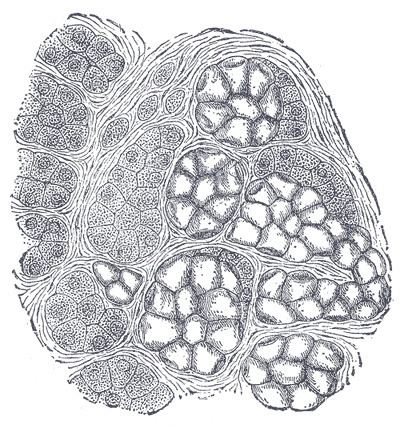Latin glandula | Code TH H2.00.02.0.02002 | |
 | ||
A gland is an organ in an animal's body that synthesizes substances (such as hormones) for release into the bloodstream (endocrine gland) or into cavities inside the body or its outer surface (exocrine gland).
Contents
Development
Every gland is formed by an ingrowth from an epithelial surface. This ingrowth may in the beginning possess a tubular structure, but in other instances glands may start as a solid column of cells which subsequently becomes tubulated.
As growth proceeds, the column of cells may divide or give off offshoots, in which case a compound gland is formed. In many glands, the number of branches is limited, in others (salivary, pancreas) a very large structure is finally formed by repeated growth and sub-division. As a rule, the branches do not unite with one another, but in one instance, the liver, this does occur when a reticulated compound gland is produced. In compound glands the more typical or secretory epithelium is found forming the terminal portion of each branch, and the uniting portions form ducts and are lined with a less modified type of epithelial cell.
Glands are classified according to their shape.
Function
Glands are divided based on their function into two groups:
Endocrine glands
Endocrine glands secrete substances that circulate through the blood stream. These glands that secrete their products through the basal lamina into the blood stream and lack a duct system. These glands often secrete hormones, and play an important role in maintaining homeostasis. The pineal gland, thymus gland, pituitary gland, thyroid gland, and the two adrenal glands are all endocrine glands.
Exocrine glands
Exocrine glands secrete their products through a duct onto an outer surface of the body, such as the skin or the gastrointestinal tract. Secretion is directly onto the apical surface. The glands in this group can be divided into three groups:
The type of secretory product of exocrine glands may also be one of three categories:
Clinical significance
Adenosis is any disease of a gland. The diseased gland has abnormal formation or development of glandular tissue which is sometimes tumorous.
